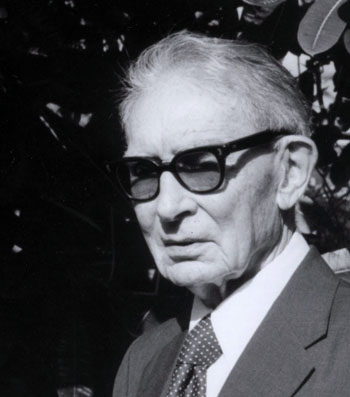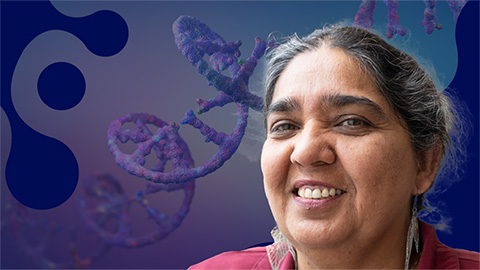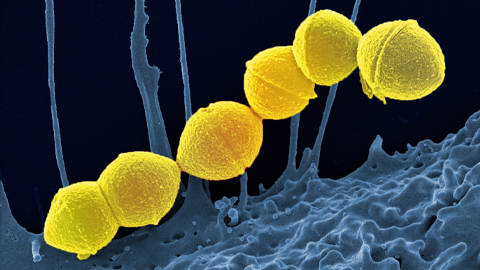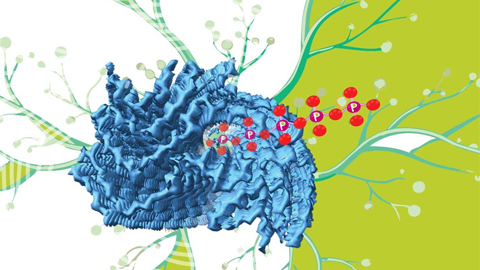Discovering essential fatty acids
In the early 1900s, dietary fat was viewed simply as a source of calories, interchangeable with carbohydrates. But in 1929 and 1930, a husband-and-wife team published two papers in the Journal of Biological Chemistry that turned the notion on its head. Through meticulous analyses of rats fed special diets, George and Mildred Burr discovered that fatty acids were critical to health. If fatty acids were missing in the diet, a deficiency syndrome ensued and often led to death. The Burrs identified linoleic acid as an essential fatty acid and coined the phrase “essential fatty acids.”
 |
| Photo of George Burr taken in 1980. Image credit: Eskind Biomedical Library, Vanderbilt University Medical Center |
The work by the Burrs “showed that fats are not there solely as calories to support growth but that they are important for proper physiology,” explains Norman Salem Jr. of DSM Nutritional Products, a company that makes bulk vitamins, lipids, carotenoids and other nutrition products. The two papers heralded “the beginning of a modern paradigm in nutritional biochemistry.”
The field of nutritional fatty acid research has exploded since the work by the Burrs and now affects our daily lives. Food manufacturers add fatty-acid supplements, such as the omega-3 fatty acids eicosapentaenoic acid and docosahexaenoic acid (more popularly known as EPA and DHA), to processed foods, and government agencies work to establish guidelines on which fats should be incorporated into healthful diets.
In a speech he gave in 1980 at the Golden Jubilee International Congress on Essential Fatty Acids and Prostaglandins at the University of Minnesota, George Burr recounted how he stumbled into the research project that changed the perception of fats (1). In 1924, as a freshly minted Ph.D. in biochemistry from the University of Minnesota, 28-year-old Burr joined the staff of Herbert Evans at the University of California, Berkeley. Evans already was famous because he, along with Katherine Scott Bishop, had discovered vitamin E two years earlier. Burr joined the laboratory as a research associate and was tasked with understanding the chemistry of the vitamin.
At the time Burr arrived at the Evans laboratory — along with a Gila monster he recently had captured on an Arizona scientific expedition and had had stuffed – his colleagues were grappling with a problem. They were trying to produce sterile female rats as controls for an assay with a diet deficient in vitamin E. But for some reason the rats were not always sterile. It seemed that some lipid component with vitamin E in it kept sneaking into their diet.
Featured JBC Classic articles
Burr, G. O. & Burr, M. M. A new deficiency disease produced by the rigid exclusion of fat from the diet. J. Biol Chem. 82: 345–367 (1929).
Burr, G. O. & Burr, M. M. The nature and role of the fatty acids essential in nutrition. J. Biol Chem. 86: 587–621 (1930).
The researchers searched the literature to figure out where they had gone wrong. They had added all the known vitamin supplements to the simple diet, but they were still getting a deficiency syndrome. Burr said in his 1980 speech that nutrition experts of the time insisted to him that fats were not necessary for a complete diet.
As he tried to figure out what was going on with the sick rats, Burr accepted an offer to join the new department of botany at the University of Minnesota. By this time he was married to a technician named Mildred (her maiden name was Lawson) who was responsible for the Evans laboratory’s stock rat colony. So that George Burr could start his new post in 1928, the couple left Berkeley, Calif., for Minneapolis in a Model-T Ford with two cages of rats. “On the cold fall nights, our pets were smuggled into hotel rooms under long overcoats,” George Burr recalled in a 1982 article (2).
While George Burr had the appointment at the university, funding was so tight that Mildred volunteered to help with the work (3). The Burrs felt that, if they were to make any headway with this nutritional syndrome, they had to exclude fats more rigorously from the simple diet and had to quantify the symptoms of the deficiency as thoroughly as possible. This way, they would be able to measure the relative curative properties of additives they put in the simple diet later on.
In the 1929 JBC paper, the Burrs described the new nutrition deficiency in detail. When fats were eliminated from the diet for several months but the amount of food wasn’t changed, the rats developed scaly skin. Their tails became inflamed and soon ridged with scales. The hind paws reddened and sometimes swelled. The fur on the back filled with dandruff. The animals lost fur around the face and throat with sores appearing. As they continued on the fat-free diet, the animals began to lose weight and, within three or four months of the weight loss, died. When they were autopsied, the Burrs noted that the animals’ kidneys and urinary tracts bore significant signs of damage. The Burrs showed that added vitamins didn’t help the animals recover from the syndrome, but adding small amounts of lard, as little as three drops, was enough to help the animal recover.
At this stage, the Burrs could conclude only that fat starvation over a period of several months caused a disease in rats that eventually led to death. They didn’t know if the rats died because of the strain of having to synthesize fats internally or because of the missing fats from the diet.
But the second paper, which appeared the next year, put the question to rest. The Burrs showed that linoleic acid was an essential fatty acid that was needed in only small amounts to support health. Their work “led them to identify polyunsaturated fatty acids” as essential nutrients, explains William Smith at the University of Michigan, Ann Arbor.
The Burrs established that the fat-deprived rats could not be cured with saturated fatty acids, such as stearic, palmitic and lauric acids. But if the rats were given linoleic acid from sources such as olive oil, lard or linseed oil, they were cured. The Burrs went on to show that complex, unsaturated oils like corn or cod liver oils were better at curing the animals than just a single fatty acid or phospholipid. They had to use physical and chemical means of separation to analyze the components of the fats, because their work preceded the days of common analytical techniques such as thin-layer and gas chromatography, spectroscopy, and automatic fractionating methods.
Their findings were “born into controversy” wrote Ralph Holman of the Hormel Institute in 1998 (3). In the 1940s, Holman was one of George Burr’s graduate students and later a research associate. Holman pointed out that, in the same issue of the JBC as the second paper, a group led by Lafayette Mendel at Yale University had a paper that concluded that fat’s nutritional value was solely in fat-soluble vitamins and calories but not fatty acids (4). In his 1982 article, George Burr remembered receiving a letter of condolence for coming to the conclusion that fatty acids were important (2).
Later work, some of it done by Holman, went on to demonstrate that linoleic acid was critical in the human diet (5, 6). As more research gave credence to the Burrs’ work, a different mindset took hold that went to the other extreme. Nutritionists believed that linoleic acid was the only essential fatty acid. “The idea that linoleic acid was the essential fatty acid persisted for a long time, even into the 1990s,” says Salem. He adds the thinking was so pervasive that linoleic acid was the only fatty acid required to be added to infant formula. It was only in the mid-1990s that the World Health Organization “said infant formula should have a fatty acid distribution more like human milk, which contained other long-chain, polyunsaturated fatty acids as well,” says Salem, citing the omega-3 and omega-6 fatty acids DHA and arachidonic acid as examples.
Salem says that modern nutritional biochemists can learn a lesson from the Burrs’ experimental procedures. By keeping the diet very simple and repurifying the proteins and sugars, the Burrs “invented the whole approach of how to exclude fat from the diet. It is a mistake people still make today,” he says. Salem explains that researchers get waylaid by the description “fat free” in a product catalog, not realizing the product may have traces of fat still in it. The Burrs did not take those risks. They went to great lengths to make sure that all the materials they were using to design the diet were truly devoid of any traces of fat.
The skin symptoms in the Burrs’ rats were striking. It is only now that some understanding of how linoleic acid plays a role in maintaining healthy skin is starting to emerge. In a recent JBC publication, recognized as one of the “Best of JBC 2011” papers, Alan Brash’s group at Vanderbilt University proposed an explanation for the critical role of linoleic acid in building the water barrier in the skin (7). Brash says that the Burrs noted that the fat-deprived rats lost more water through their scaly skin. By using a series of analytical techniques, Brash’s group demonstrated that two particular lipoxygenases are responsible for oxidizing linoleic acid esterified in a special ceramide to allow the subsequent covalent bonding of epidermal proteins and ceramides together to produce a functional barrier to water loss.
Mildred Burr died in 1962. George Burr’s career later took him to Hawaii and Taiwan, working on photosynthesis in agricultural crops. Burr was the first to discover that sugarcane used C4 carbon fixation. He died in 1990.
This article originally was published in The Journal of Biological Chemistry.
References
- Burr, G. O. Prog. Lipid Res.20, xxv–xxvi (1981).
- Burr, G. O. Prog. Lipid Res.20, xxvii–xxix (1981).
- Holman, R. T. J. Nutr.118, 535–540 (1988).
- 4) Reed, L. L. et al. J. Biol. Chem. 87, 147–174 (1930).
- Hansen, A. E. et al. J. Nutr.66, 565–576 (1958).
- Holman, R. T. et al. Am. J. Clin. Nutr.35, 617–623 (1982).
- Zheng, Y. et al. J. Biol. Chem. 286, 24046–24056 (2011).
Enjoy reading ASBMB Today?
Become a member to receive the print edition four times a year and the digital edition weekly.
Learn moreGet the latest from ASBMB Today
Enter your email address, and we’ll send you a weekly email with recent articles, interviews and more.
Latest in Science
Science highlights or most popular articles

Transforming learning through innovation and collaboration
Neena Grover will receive the William C. Rose Award for Exemplary Contributions to Education at the 2025 ASBMB Annual Meeting, April 12–15 in Chicago.

Guiding grocery carts to shape healthy habits
Robert “Nate” Helsley will receive the Walter A. Shaw Young Investigator in Lipid Research Award at the 2025 ASBMB Annual Meeting, April 12–15 in Chicago.

Quantifying how proteins in microbe and host interact
“To develop better vaccines, we need new methods and a better understanding of the antibody responses that develop in immune individuals,” author Johan Malmström said.

Leading the charge for gender equity
Nicole Woitowich will receive the ASBMB Emerging Leadership Award at the 2025 ASBMB Annual meeting, April 12–15 in Chicago.

CRISPR gene editing: Moving closer to home
With the first medical therapy approved, there’s a lot going on in the genome editing field, including the discovery of CRISPR-like DNA-snippers called Fanzors in an odd menagerie of eukaryotic critters.

Finding a missing piece for neurodegenerative disease research
Ursula Jakob and a team at the University of Michigan have found that the molecule polyphosphate could be what scientists call the “mystery density” inside fibrils associated with Alzheimer’s, Parkinson’s and related conditions.

